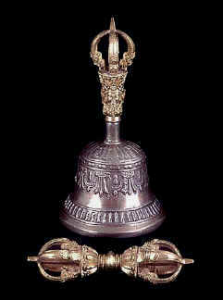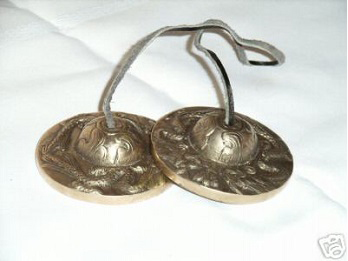Sound Instruments
According to information passed down through Tibetan oral tradition, the existence of singing bowls dates back to the time of the historical Buddha Shakyamuni (560 – 480 B.C.). The tradition was brought from India to Tibet, along with the teachings of the Buddha, by the great tantric master Padmasambhava in the 8th century A.D. They are believed to have originated in India and Bengal some 3000 years ago.
Many stories describe the bowls as having made their humble beginnings as begging bowls and also served as a tool for meditation. When the bowl was invited to sing it acted as a call for the practitioner to return to mindfulness or to be in the
present moment. It is however also thought that ancient sects of shamans, which existed in Tibet before the advent of Buddhism, used the bowls primarily as a musical instrument
Singing bowls produce sounds which invoke a deep state of relaxation which naturally assists one in entering into meditation, the ultimate goal being that of enlightenment. They are a quintessential aid to meditation, and can be found on private Buddhist altars, and in temples, monasteries and meditation halls throughout the world. Many people from western civilisations have adopted the use of singing bowls into their lives for the beauty and individuality of their sounds.
So why do the bowls ‘sing’
A metallurgical analysis, done by the British Museum in London, reveals that these instruments are made of a 12-metal alloy consisting of silver, nickel, copper, zinc, antimony, tin, lead, cobalt, bismuth, arsenic, cadmium and iron. The practise of creating these bowls was done with much ceremony and at specific times of the day and the knowledge passed on from father to son. One of the most fascinating things about these ancient bowls is the quality of the sound an ancient bowl cannot be produced today. In fact producing this quality of singing bowls is a lost art.
Today in India and Nepal and the Katmandu valley skilled craftsmen are working to retrieve these ancient techniques of making singing bowls even though the original craft has been lost. These newer bowls are made of an alloy of bronze, iron, and zinc.
The quality of the sound of the bowl produced depends greatly on size, shape and the thickness of the metal. Bowls typically range in size between five to thirteen inches and striking the rim of the bowl much like ringing a bell produces a harmonic resonance whilst running a mallet around the lip increasing or de-creasing the speed can produces different tones (overtones). Singing bowls are important to both Hindu and Buddhists, Sound is an important part of spiritual practice.
Vibration is the most essential characteristic of singing bowls. The pure sound and tone created when the bowls are invited to sing penetrates throughout the body and their music can be felt on a cellular level as well as heard. The harmonious vibration sound field which is produced resonates the light body chakra and corresponding physical area of the body.
In Buddhism of the nine ways to reach enlightenment the seventh is through sound. In Hinduism the sound is said to balance the chakras. This multidimensional network allows the energy of various vibrational characteristics to flow into the body and act on a cellular level to release stored emotions and memories
Some of the recognised areas of the body which are said to be assisted by the vibrational resonance of Tibetan singing bowls are defined as:
Chakra
1st Root / Base
Note C
Location base of spine
Associated with Adrenal glands, spinal column, kidneys
2nd Sacral/Naval
Note D
Location Sexual organs
Associated with Gonads and reproductive organs
3rd Solar Plexus
Note E
Location Naval area
Associated with Pancreas ,Abdomen,Liver, Stomach,Nervous system
4th
Note F
Location Heart
Associated with Heart Thymus, Blood, Circulatory system.
5th
Note G
Location Throat Thyroid,
Associated with Lungs, Gums, Throat, Mouth
6th
Note A
Location Middle of forehead, Pituitary gland
Associated with Nose, Lower brain, left eye, ears
7th
Note B
Location Crown Pineal gland,
Associated with Upper brain, right eye
In addition to their traditional usage for meditation, Tibetan singing bowls are used for deep relaxation, stress reduction, holistic healing, Reiki, chakra balancing, and World music. Many people find that the rich blend of harmonic overtones which the bowls produce have a direct affect upon their chakras as above. Meditating on the subtle sounds of the Tibetan singing bowl tunes one in to the universal sound within and without.

Musical tones have always been an essential part of the gathering of people through the ages. Tones are a language all there own, and the right bell is an essential part of any ceremony or sacred space.
There are a number of types of Tibetan bells including Tingsha or as they are some times called Ting Sha. Playing the Tibetan bells usually causes an immediate centering effect. The tones set up a “frequency following response” that creates a balancing left/right brain synchronization. Tingsha bells are fashioned from seven metals instead of the twelve metals used in the creating singing bowls.
Musical tones have always been an essential part of the gathering of people. Tones are a language all there own, and the right bell is an essential part of any ceremony or sacred space.
The bell and Puja stick Photo 1 below] are two items traditionally used by many spiritual traditions throughout the East. The bell represents wisdom and the feminine aspect of the divine while the Puja stick represents the creative and forceful male energy. During ceremonies and rituals the bell is held in the left hand while the stick is in your right hand. As the sound of the bell resonates the bell and stick balance the negative with the positive to harmonize ones life and surroundings. These items are also used for space clearing in Feng Shui.
Traditonal Tingsha cymbals [centre] carry the eight auspicious symbols – a parasol, golden fish, golden vase, lotus, conch shell, eternal knot, victory banner, and an eight-spoked wheel, and are joined together by a leather thong. Begin and end your meditation sessions with the sound of Ting Sha.
The bell and dorje, the symbolizes the feminine principle, the wisdom of emptiness, while the dorje, or vajra, symbolizes the masculine principle, that of compassion expressed through skillful means. The union of these two principles is an enlightened mind.
Examples of Tibetan Bells, Tingsha Bells and a Dorge and the Tingsha Bells that Sheila uses to create her Vibrational sound programs for Sounds from Source and more.
www.soundsfromsource,com



